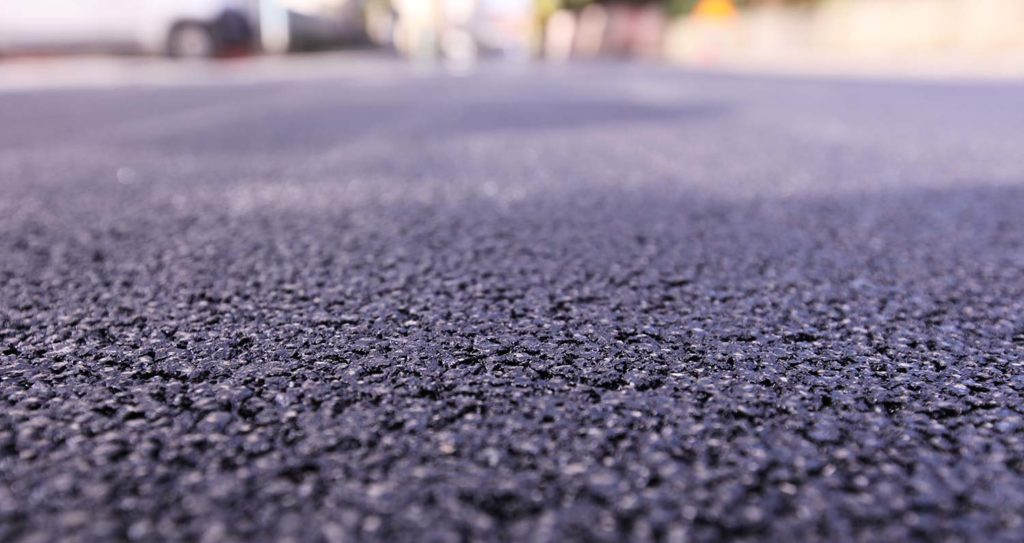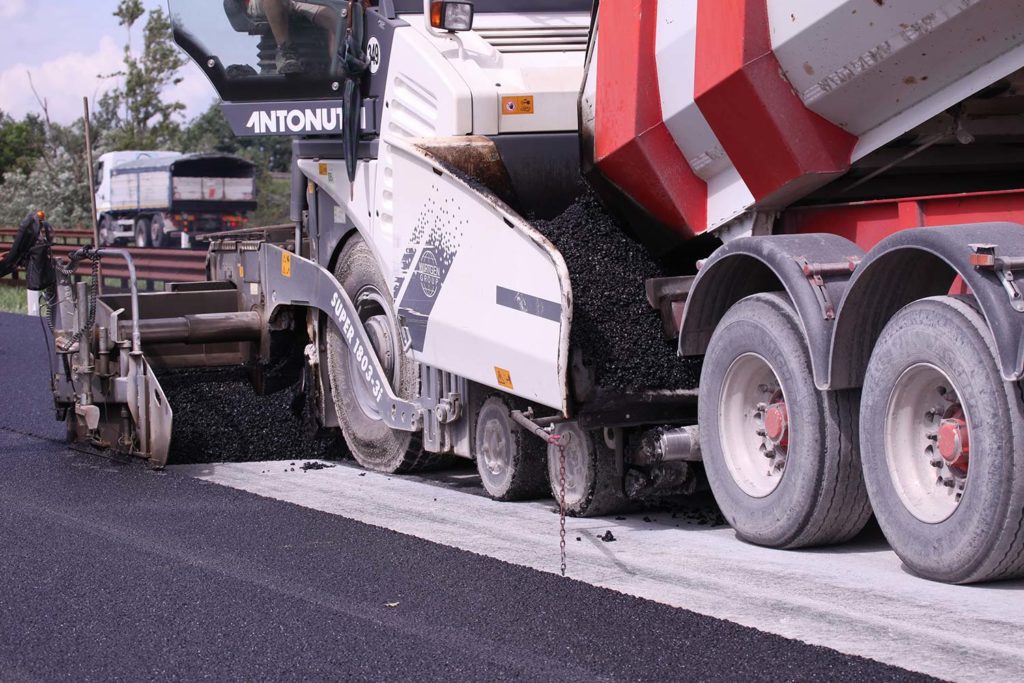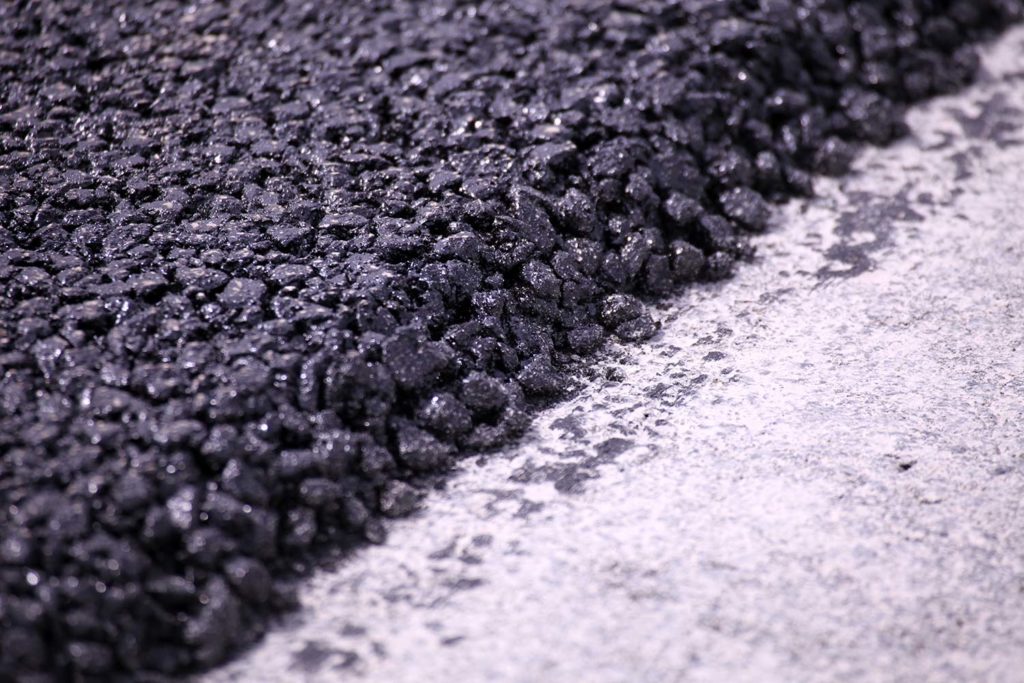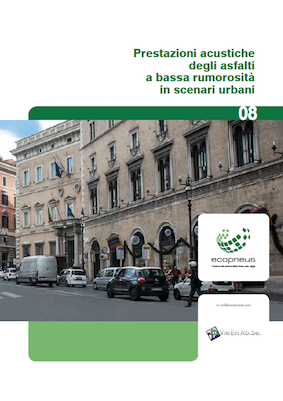Mix preparation: Wet & Dry technologies
 Bituminous conglomerates with rubber powder are part of a “new generation” of mixes. They are used to make base layers, (high modulus) link layers, and special wear surfaces with high mechanical resistance and low noise emissions. Based on the grain size characteristics and recycled rubber, these mixes allow to optimise the surface performances guaranteeing greater durability, stability, and safety of traffic movement.
Bituminous conglomerates with rubber powder are part of a “new generation” of mixes. They are used to make base layers, (high modulus) link layers, and special wear surfaces with high mechanical resistance and low noise emissions. Based on the grain size characteristics and recycled rubber, these mixes allow to optimise the surface performances guaranteeing greater durability, stability, and safety of traffic movement.
Moreover, bituminous conglomerates modified with rubber from End-of-Life Tyres are easy to make for every production plant. It is possible to produce them in two ways:
- WET METHOD: It consists in the modification of base bitumen with rubber powder of appropriate quality and grain size. The WET manufacturing process requires the mixing and incorporation of rubber powder into the bitumen for about an hour. It allows to obtain high-performing binders whose characteristics depend on the type of base bitumen and the quantity of powder used. The most known WET product is the so-called “asphalt rubber” . It is a high-viscosity binder that contains about 20% of rubber powder. A high percentage of it can be used in the bituminous conglomerate. Thanks to this binder, the bituminous conglomerate acquires its known characteristics of resistance and durability. It is a consolidated technology thanks to international experience (it has been used in the U.S.A. since the 1960s) and 11 years of its application on the Italian territory.
- DRY METHOD: It consists in the addition of rubber powder to the bituminous conglomerate directly in the production plant mixer (“rubberized asphalt”). Rubber powder can be added or made it to react with bitumen or similar elements to produce a “ready-to-use” additive. This additive can, then, be used in the conglomerate production plants without mixing the rubber in the bitumen. A modified bitumen (PmB) has been present on the national market for some years. It has been specifically formulated to guarantee the maximum synergy with rubber powder. As such, it allows to produce an elastomeric mastic with higher mechanical performances. The latter is, then, used for making low-noise emission road surfaces with a “warm” technology.
These conglomerates can be used for every surface layer (base layers, link layers, wear layer). Their use depends on the eventual indications described in the technical specifications of the contracting bodies or, if they are not available, on the convenience and practicality identified by producers and companies during their use.
Production extended to lower temperatures: “Warm Mix” Asphalts
 The HMA (Hot Mix Asphalt) technology is the one commonly used in the production of road asphalts. It consists in the production and laying of the bituminous conglomerate at temperatures between 140 and 180°C, according to the used binder, the distance of the working site from the production plant, and the weather conditions. The adding of rubber powder to the bituminous mixes usually requires a 15-20°C temperature increase (that is, production at 160-185°C).
The HMA (Hot Mix Asphalt) technology is the one commonly used in the production of road asphalts. It consists in the production and laying of the bituminous conglomerate at temperatures between 140 and 180°C, according to the used binder, the distance of the working site from the production plant, and the weather conditions. The adding of rubber powder to the bituminous mixes usually requires a 15-20°C temperature increase (that is, production at 160-185°C).
Thanks to the use of specific additives, the WMA (“Warm Mix Asphalt”) technology allows to produce and lay the bituminous conglomerate at temperatures that are 30-40°C lower than the corresponding HMA mixes. A lower production temperature allows for the reduction of fumes and odours produced by the hot conglomerate. This improves the overall conditions of the working site, especially in urban areas. The addition of WMA additives improves the end-product workability. Indeed, the end-product is more easily compactable even in non-ideal conditions. Both the WET and DRY conglomerates can be used hot or warm, although all the applications of conglomerates modified with powders from ELTs are currently made according to the WARM technology. Indeed, the latter guarantees lower emissions during the production phase, savings in energy and in the emissions of Co2 equivalent, better (even manual) workability, and greater quality of workers’ health on the work place.
Recyclability of modified asphalts: the use of asphalt millings for road surfaces
Studies carried out by the Polytechnic University of the Marche Region of the city of Ancona demonstrate that the granulate of recovered bituminous conglomerate (commonly known as “asphalt millings”) can be re-used for several times – both in hot and cold mixes. Moreover, a performance increase has been recorded compared with commonly used millings.
 Ecopneus is partner in the RubberRap research project, together with the University of the Studies of Palermo and the French University Gustave Eiffel. This project aims at supplying scientific data with reference to the possibility of effectively use asphalt millings, first in a laboratory, and then in situ. The project represents the implementation of a multidisciplinary experimental project that aims at engineering regenerated rubberised asphalt, determining its mechanical performances and the quality of the fumes produced during the mixing. The laboratory testing phase shall be carried out comparing conventional mixes with Rub-RAP ones produced with at least two ageing cycles.
Ecopneus is partner in the RubberRap research project, together with the University of the Studies of Palermo and the French University Gustave Eiffel. This project aims at supplying scientific data with reference to the possibility of effectively use asphalt millings, first in a laboratory, and then in situ. The project represents the implementation of a multidisciplinary experimental project that aims at engineering regenerated rubberised asphalt, determining its mechanical performances and the quality of the fumes produced during the mixing. The laboratory testing phase shall be carried out comparing conventional mixes with Rub-RAP ones produced with at least two ageing cycles.
The first field research of this project has been held in the province of Trapani recently. Test mixes have been laid to verify the absence of operative limitations during the mixing, laying and compacting phases. Workers, entrepreneurs and technical figures of some councils of the Province of Trapani have been able to ascertain how the workability, the fume emissions, and the cleanliness of the equipment are actually better than conventional asphalts.
Thanks to this project, a specifically engineered powder made with rubber recycled from ELTs has been tested. This powder has been developed in the USA and it improves the powder compatibility with bitumen. The used technology does not require any modification of the asphalt plants or of the specific equipment used for asphalt laying and compacting. The technological adaptation of the Italian mixes is currently being developed by the laboratories of Roads, Railways and Airports of the Department of Engineering of UNIPA within the scope of the RUBBERAP projects and with the support of Ecopneus.
For further reading

The technical handbooks on modified asphalts
In collaboration with universities and research centres, Ecopneus has promoted a series of handbooks where technical aspects, case histories, formulations, and performances of the various typologies of rubberised asphalt are scientifically presented. The objective is to favour the circulation of information and technical updates among all the subjects of the Italian asphalt chain. In its turn, this greater circulation of information aims at leading to a wider use of this valid application on our roads. Download them all!
08. Prestazioni acustiche degli asfalti modificati in scenari urbani
13. Guida per la produzione di bitumi con polverino di gomma da PFU
16. La Variante Canali di Reggio Emilia: una strada green
17: Strati di usura con polverino da PFU per la viabilità urbana

 Collect ELT
Collect ELT